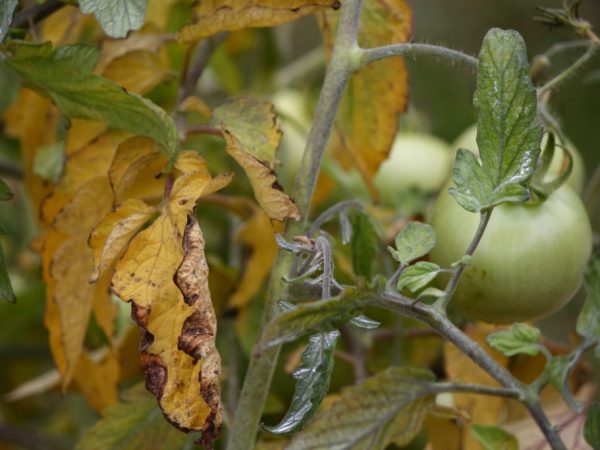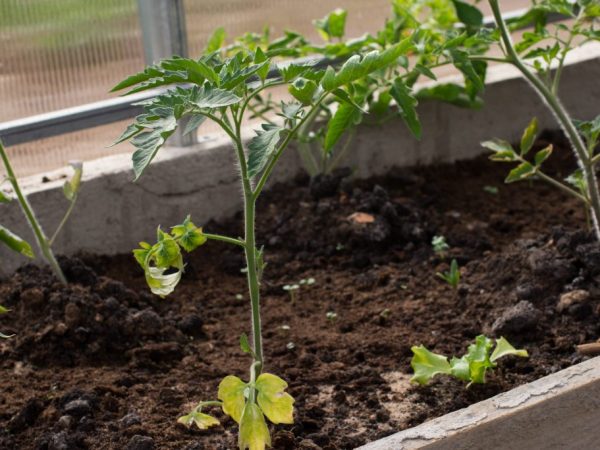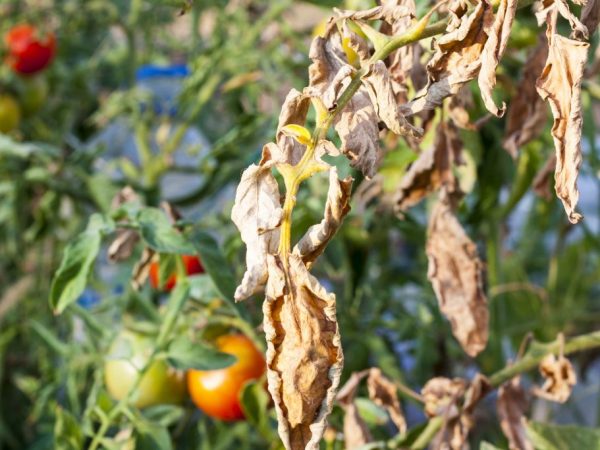Why do tomato seedling leaves turn yellow
Those who have at least once encountered the cultivation of tomatoes know firsthand how often the leaves of tomato seedlings turn yellow. It is worth saying that this problem can lead to loss of crops, so you should not turn a blind eye to it. It so happens that the disease develops with lightning speed, literally, in one evening, it also happens that the process is delayed and the tomato seedlings turn yellow gradually. Gardeners and gardeners are wondering why this is happening, what is the reason for such changes. Today we will describe in detail what are the reasons why tomato seedlings begin to turn yellow, how to save the bush and how to prevent yellowing of tomato seedlings.

The leaves of tomato seedlings turn yellow
Causes of yellowing tomato leaves
It is worth saying that growing tomatoes is a fairly simple and straightforward process, and the vegetable itself is considered one of the most unpretentious. If you notice any deviations from the norm in the development of the plant, you should immediately understand the reasons and make attempts to eliminate them, the same applies to the yellowing of tomato leaves.
The fact is that when growing any crop, be it a vegetable or a fruit, there are requirements, not meeting which leads to the development of certain problems. Thus, if mistakes were made when growing tomatoes, a problem such as yellowing of the foliage of tomato seedlings may develop. We list the most common answers to the question why the leaf of tomato seedlings turns yellow:
- Too intensive watering
- Tight container for tomato seedlings before the picking stage
- Lack of nitrogen in fertilizer
- It's too dark in the greenhouse
- Soil acidity readings are too high
- Pathology of root development or mechanical damage to the roots
- Sudden changes in temperature, most often hypothermia
- Violation of the humidity regime (excess or lack)
- Poor or insufficient feeding
- Fungal disease
There are a lot of reasons for the yellowing of the leaves of tomato seedlings, but most of them can be called in one phrase - violations of the conditions of care and cultivation, since much depends on the person, namely on his actions aimed at growing bushes. Next, we'll talk about the most common causes that cause yellow foliage.
Root system problems
In fact, any problems with seedlings almost always signal that something is wrong with the roots. For example, with regard to tomatoes, it very often happens that their roots grow so much that they turn into one continuous lump that cannot be untangled. Of course, such metamorphoses cannot but affect the appearance of the plant, that is, the state of the leaves.The problem can be corrected with the help of a transplant so that the plant has more free space, but this will not guarantee that the leaves will regain their normal appearance, that is, they will stop turning yellow and the bush will not die.
It also happens that the root system gets too much space, which allows the bush to restart the new root growth system too often. As a result, it turns out that young roots grow all the time, which leads to yellowness on the foliage, after which they dry out, making room for new shoots. If the problem is not noticed in time and solved by replanting the bush, then there is a high probability that the tomatoes will die.
Temperature changes
Tomatoes are most afraid of a sharp cold snap, as they are a heat-loving plant. And this applies not so much to the upper part of the plant as to its root system, that is, the area that is located directly in the ground. The lower foliage on tomato seedlings can begin to turn yellow after the first incident, and often this does not go unnoticed, there is a possibility that the bush will simply stop bearing fruit.

Tomato seedlings are afraid of frost
To make sure that the appearance of a yellow color on the lower leaves is exactly hypothermia, you should carefully consider the tomato leaf. With hypothermia, bluish spots will appear on the greens along with yellow ones.
Damage to the root system
Often the cause of yellowing of tomato seedlings is banal mechanical damage to the roots. This can happen at any stage of plant maintenance, for example, when planting seedlings, while loosening the soil or during the period of getting rid of weeds.
Usually, such a problem should not be solved in any special way, everything is resolved by itself, that is, the tomatoes take root on their own. Usually, it takes about 2-5 days for the adventitious processes of the roots to develop, after which the cotyledon leaves will regain their green color.
Moisture deficiency
Despite the fact that tomatoes have a well-developed root system, the root can develop up to 2 meters in length, the plant does not tolerate a lack of watering. The fact is that the lower feeding part of the root does not lie so deep, only at a depth of about 30 centimeters.
If you do not have enough watering, there is a chance that the leaves will turn yellow. Often those leaves that are at the top suffer, in addition, their shape changes, they curl inward towards the tips.
High humidity
If you water the plant too often, it also appears on the bush's appearance. First of all, active growth of leaves will occur, which will occur in the first half of the growing season. It is worth saying that with the active development of the vegetable, you can easily skip this moment, which will lead to the foliage turning yellow. If nitrogen ceases to penetrate into the soil, the leaves will become more lethargic and will certainly acquire a characteristic yellow-brown tint, and then completely fall off. Moreover, this will affect the fruits, they can crack and lose their presentation.
Deficiency of trace elements in the soil
Not only nitrogen deficiency negatively affects the condition of tomato foliage. The appearance of yellow spots on the leaves can provoke a lack of many other trace elements. For example, if the bush has received less calcium, then chlorosis may appear, manifesting itself as apical rot on the tops. In addition, one of the characteristic features is the yellow color of the foliage.
If, in addition to changing the color of the leaves, you notice some thickening of the leaves, as well as a thickening of the stem, then we can say that the culture does not receive enough sulfur. In the case when, in addition to the leaves turning yellow on tomato seedlings, dry shoots are observed, even if the plant receives a sufficient amount of moisture, then we can say that there is not enough manganese in the soil.
There are characteristic signs that there is not enough iron in the ground, if you notice that the foliage has turned yellow, and the leaves have twisted to the top. If the leaves contain not only yellow, but also red, then you should think about the fact that there is not enough magnesium in the top dressing.
Fungus

Fungus can lead to wilting of the plant
Tomato seedlings can turn yellow due to fungus. This reason is caused not just by an error in care, but is a separate disease, which is classified as fungal. It should be noted that a characteristic indicator of the defeat of the Fusarium fungus is not only yellowing of the leaves, but also a decrease in the turgor index. Outwardly, the bush will look as if the last watering was done about 10-14 days ago. The problem is aggravated by the fact that the fungus remains viable for a long time in the soil, which increases the negative impact on the yield.
The fungus begins its action from the roots, after which it rises higher, already affecting the stems, and then the leaves, changing their color from green to yellow. If the problem was discovered too late, then there is a possibility that the vascular system of the tomato may lose the ability to absorb nutrients from the soil. This will entail irreversible changes, such as delay in development and growth, as well as the loss of the ability to bear fruit. Even if the worst does not happen, and the bush bears fruit, they will not grow large, even if the desired variety of tomatoes was planted.
The source of infection can be contaminated tomato seed, as well as the remnants of vegetables from the compost, as well as tools that were used for care and harvesting. In addition, it should be said that the wind and too high air temperature can contribute to the spread of the fungus. We will learn how to fight disease in order to save the harvest.
Fighting fungus methods
It is customary to distinguish three methods of combating the fungal disease parasitizing on tomato bushes.
Biological method
This type of fungal disease control is most often used in a greenhouse. You need to remove the top layer of soil, usually a depth of about 20 cm is chosen. After that, fertilizer is brought into the greenhouse, most often manure. After that, the harvested soil layer can be returned to its place. According to scientific data, then complete disinfection will occur after 2 years. You are required to carefully look after the site, get rid of weeds in time and dig it up at least once a year.
Thermal method
In order to use thermal methods, it is also worth removing the top layer of the earth, choosing the same recommended depth, after which you need to store the earth in boxes. Next, you have to conduct a thorough disinfection of the entire earth by heating it on fire. It should be said that before this procedure, it is important to generously moisten the soil. In the process of warming up, you need to constantly stir the earth so that it warms up evenly. Also, make sure that the temperature does not rise above 100 degrees, otherwise it will kill all the minerals in the ground.
Chemical method
In the fight against fungus, many prefer more aggressive methods, for example, chemical, namely the cultivation of the earth with chlorine lime. In comparison with the above methods, this one works much faster and more efficiently. In order to prepare the solution, you will need 200 grams of powder per 5 cubic meters. It is recommended to carry out chlorination in the autumn, only in this way such treatment will not negatively affect the growth of the plant.
How to deal with yellowness on leaves
Many people wonder if it is possible to save those plants that have yellow leaves. This can be done, but only at the initial stages, when the problem has not become global. For a start, it is worth reviewing watering, perhaps mistakes were made.After they are eliminated, you need to fertilize the soil, and the composition of the fertilizer mixture should contain the maximum concentration of salt. It is not recommended to exceed the concentration of the fertilizer mixture above 10 grams per liter of water, otherwise it may cause a burn. The prepared solution should be sprayed on the culture, once a day until new foliage grows.
It is worth saying that it will still not be possible to completely restore the affected leaves on the seedlings; it is better to direct all efforts to ensure that the new green leaves completely replace the affected ones. If the treatment is carried out in a timely manner, but the most terrible consequence will be a slight delay in the ripening of the crop, while its quality and quantity will remain unchanged.
Preventive measures
In order to prevent yellowing of seedlings, it is worth taking care of preventive measures in advance, that is, you need to create the most acceptable conditions for growing a tomato, then the leaves will not turn yellow. This includes all activities, from the selection of soil, ending with the observance of the conditions of humidity and light.
As for feeding, it should be carried out exactly one week after the first shoots appear. Further, it should be repeated after two weeks. In addition, it is important to harden the culture, that is, gradual accustoming to temperature changes. 2-3 weeks before the disembarkation is carried out, you need to strengthen the greens, namely to accustom them to the influence of the sun's rays, for example, on the windowsill. It is good if conditions are created on the windowsill when the rays of the sun are not direct. To do this, the pallet with seedlings is taken out into the street, starting from a few hours, gradually increasing the time, and then brought home.
Do not forget to regularly water the seedling beds, but do not overdo it in this matter. It is important to choose the correct container for its content, it is important that there is a drainage hole in it, that is, air access, and also to make a pick in time, that is, landing in a large container.
Now you know why the leaves of tomato seedlings turn yellow. In conclusion, let's say that yellowing of leaves or their tips is not a separate disease, but just a signal that something is wrong with the plant.

